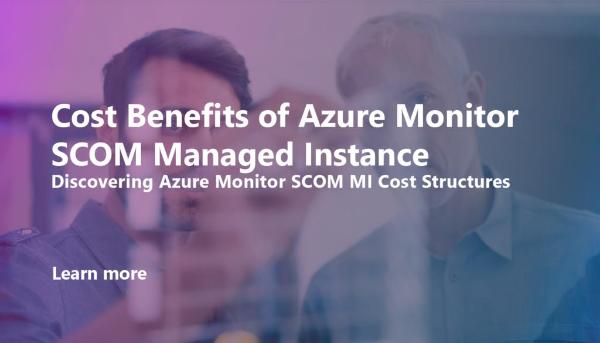Cost Benefits of Azure Monitor SCOM Managed Instance
Microsoft has just released the latest news regarding the cost structures for Azure Monitor SCOM Managed Instance. In this recent publication by Aakash Basavaraj on the Microsoft Tech Community, valuable insights have been shared on the benefits and cost-effectiveness of transitioning from the traditional System Center Operations Manager (SCOM) to the cloud-based Azure Monitor SCOM Managed Instance (SCOM MI).
This blog post provides a condensed overview, highlighting key considerations and showcasing potential cost savings of up to 44%. Let’s delve into the details of this transformative shift and explore how organizations can optimize their operations while embracing the power of Azure Monitor SCOM MI.
Understanding Azure Monitor SCOM Managed Instance
Azure Monitor SCOM Managed Instance is a cloud-based service designed to offer the same robust functionality as SCOM on-premises, without the burden of managing and maintaining infrastructure. This transition allows organizations to monitor resources both on and off Azure, seamlessly integrating with various Azure services, including Log Analytics, Azure Managed Grafana, and Power BI. SCOM MI ensures compatibility with existing SCOM management packs and agents, facilitating a smooth migration process.
Cost Benefits of Azure Monitor SCOM Managed Instance
The cost benefits of adopting Azure Monitor SCOM MI are significant and multifaceted, contributing to a potential savings of up to 44% compared to SCOM on-premises. Let’s break down the key areas of cost efficiency.
Reduced Infrastructure & Maintenance Costs
SCOM MI eliminates the need for organizations to manage physical infrastructure, including server racks, network cables, and security measures. Azure’s scalable and reliable infrastructure ensures organizations only pay for the resources they use, mitigating concerns about downtime and performance issues.
Reduced IT Labor Costs
Microsoft’s full management of SCOM MI translates to automatic updates, patches, scalability, and security, reducing the burden on internal IT teams. Efforts required for provisioning, patching, and scaling SCOM MI are significantly reduced, estimating a remarkable 40% reduction in time (and labor cost) compared to maintaining SCOM on-premises.
Optimized Licensing Costs
SCOM MI operates on a Pay-As-You-Go (PAYG) model, eliminating the need for organizations to purchase, renew, or manage licenses. Access to all Azure Monitor features enhances the monitoring experience and provides additional insights and value without incurring additional licensing costs.
Cost Comparison – A Snapshot
To illustrate the potential cost savings, Microsoft has prepared a comparison table based on a scenario of monitoring 500 VMs, showcasing the annual costs for both SCOM on-premises and Azure Monitor SCOM MI.
| Cost category | SCOM on-premises | Azure Monitor SCOM managed instance |
| Infrastructure (Hardware + Software) To monitor 500 VMs, you need 2 SCOM servers with Windows OS, 1 SQL server with Windows OS, server racks, storage disks etc. | $13,812 (annually) | $27,780 (no discount) $12,586 (max discount) |
| Maintenance cost (Security, lease, electricity, network, etc.) | $4,443 (annually) | $0 (included under infra cost) |
| IT labor cost (administration) | $116,800 (annually) | $70,080 (annually) |
| Licensing System Center license to manage 500VMs is $75,747. If you are using all SC products, the operating license cost for SCOM will be least ($12,625).SCOM MI license is $6/VM/month. | $12,625 (If all SC products used) $75,747 (If SCOM only used) | $36,000 (annually) |
| Annual cost range | $147,680 to $210,802 | $118,666 to $133,860 |
| Costs savings(once you move to SCOM MI to monitor 500VMs) | 20% if SCOM onprem only used & No Azure discounts applied36% if all SC products used, max Azure discounts applied44% if SCOM onprem only used, maximum Azure discounts applied | |
Disclaimer: The table includes representative numbers only; accurate Azure costs should be obtained from the Pricing Calculator | Microsoft Azure.
Getting Started with Azure Monitor SCOM Managed Instance
The decision to migrate from SCOM on-premises to Azure Monitor SCOM MI involves a comprehensive evaluation of cost savings, operational efficiency, and organizational goals. While the numbers presented in the comparison table provide a general overview, it’s crucial for organizations to consider their specific requirements and preferences.
For those interested in exploring Azure Monitor SCOM MI, Microsoft provides a starting point here. It is recommended to engage with Microsoft sales representatives for clarity on plausible discounts and actual cost savings.
Should you have any questions or feedback regarding your monitoring needs or the migration process, feel free to contact us below. We look forward to assisting you in unlocking the full potential of Azure Monitor SCOM Managed Instance.

